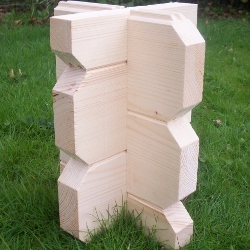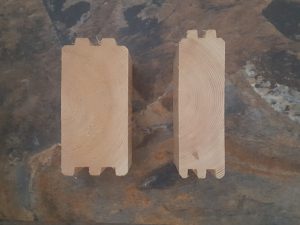Log Cabin Wall Logs
You have a choice of 44mm or 70mm thick interlock wall logs on your Astwood log cabin.
Our wall logs have a double tongue and groove profile for extra strength. The wall logs are locked securely together in the corners of the log cabin by the interlock system we use. This makes a solid and wind proof structure.
The thickness provides strength to the structure and natural insulation which will keep the inside of the your cabin at an ambient temperature.
44mm wall logs are suitable for most sizes and styles of log cabin. They are sturdier over longer spans than thinner logs. They are fine to use for home offices etc but they should not be used for residential log cabins.
70mm wall logs are suitable for most sizes and styles of log cabin. Although they are thicker than 44mm wall logs they are still not really suitable for residential log cabins. 70mm wall logs have to be cut from the top of the tree so they are rarer and we cannot be so choosy. 70mm wall logs usually have more shakes (small splits) in them.
44mm wall logs can be straight cut or chamfered at the ends.
70mm log cabin wall logs are always straight cut at the ends.
Unfortunately we don’t sell the wall logs separately.


Our Timber
We use Scandinavian 5ths redwood subject to availability.
Redwood is a type of Pine and is intended for jobs where the wood will be seen. It is mostly free from knots and splits and generally has much less warp than whitewood. Redwood gives a better machined finish because of its grain.
Grades – Unsorted is the highest grade used for furniture. Scandinavian 5ths are the next grade down. Russian 4ths are similar but less consistent and can sometimes have more dead knots or larger knots. Scandinavian 6ths has larger and more frequent knots and can suffer dead knots which can fall out after a period of time, it is commonly used for sheds and fencing. Russian 6ths is very poor quality and is used for pallets and packaging.
Whitewood is Spruce intended for woodwork that will not be seen such as joists, framing etc. It does not the visual appeal of redwood. It may have splits and its knots are unstable. It may have some warp. The quality has improved over the years and some is good enough to use for jobs where the wood is seen. It is cheaper than redwood and is often used for sheds.

